LAST EDITED ON Feb-29-20 AT 08:25 PM (EST)
The Gun of the Week this week should require no introduction to the military history and/or war movie buffs in the audience.
Photograph from Wikimedia Commons, by author with username Curiosandrelics
It is formally known as the United States Rifle, Caliber .30, M1, but to the two generations of American soldiers who carried it into battle all over the world, it was called simply by the name of its designer: the Garand.
(As everyone who writes on this subject must, I will now take a moment and note that Garand pronounced his name to rhyme with "errand", not, as most laypeople say it when talking this rifle, "the band".)
The history of the M1 Garand rifle is a long and convoluted story, one which has been told much better than I can tell it here. For all the technical and political details of the 20-plus-year process by which it came about, I'd recommend Hatcher's Book of the Garand, by the late Major General Julian S. Hatcher. Hatcher and his brother James were Army ordnance officers in the early 20th century (James was actually the designer of one of the competitors to the Garand rifle) and were thus involved in the process at pretty much every stage.
The short version is this: The United States Army first started taking an interest in self-loading rifle technologies shortly before World War I, when the current service arm, Springfield Armory's M1903 bolt-action rifle, was still fairly new. A few early automatic and semi-automatic weapons saw service during that war, most notably with the French Army; unfortunately, one of those weapons was the Chauchat machine gun, which garnered a largely-unearned reputation for being the worst gun in the world which it still carries to this day. By the end of the war, US forces had access to the M1918 Browning Automatic Rifle (BAR), but despite its name that's really more of a light machine gun—a special-purpose weapon, not suitable for general infantry issue.
As a result, and because the Army's ordnance procurement process, then as now, was among the most ponderous and unwieldy things in the bureaucratic world, it took them until quite a few years after the war to start seriously testing semi-automatic shoulder arms for their own use. Among the contenders were a gas-operated rifle designed by a Dane with the sublimely, delightfully appropriate name Søren Bang, an elegant but complicated toggle-locked design by the great but sadly now-little-known American firearms designer John Pedersen, and a rifle offered by the French-Canadian engineer John Cantius Garand, who worked for the Springfield Armory at the time.
Garand was an interesting chap, as his middle name might tend to suggest. There is a photograph of him at the excellent Springfield Armory National Historic Site that neatly encapsulates his approach to life. It shows him, dressed in suit and tie, his hair neatly styled, figure skating in the parlor of his home in Springfield, which he had a habit of flooding in wintertime specifically for the purpose. (The parlor, not the whole house. :) The photo is actually a composite, but sadly the museum collection's records are silent as to who made it or why. It's documented that the picture depicts something Garand was really known to do, however.
One of the odd vagaries of military procurement, which like everything else is gone into in greater detail in Hatcher's Book of the Garand, is the fact that Garand's rifle, like the Pedersen and indeed all the serious candidates in the original 1924-1932 trials, was originally developed around a smaller, lighter cartridge than the one the M1 would ultimately be famous for using. One of the lessons of World War I, it seemed at the time, was that the existing full-power rifle cartridges (the US .30-'06, .303 British, German 8mm Mauser, Russian 7.62×54mmR, and so on) were far more powerful and longer-range than infantrymen actually needed. A cartridge with a smaller bullet and lighter powder charge would enable infantrymen to carry more ammunition and employ it more effectively. The 1924 trials rifles were specified accordingly. John Pedersen had designed just such a cartridge, .276 Pedersen, in 1923, and both Pedersen and Garand developed rifles using said cartridge. Garand also worked on a version of his rifle in .30-'06, apparently as a sort of engineering exercise, but work was ordered stopped on it in 1928 in favor of refinements to the .276 version, which was then seen as the wave of the future.
Garand's .276 rifle won those trials, and in January of 1932, it was formally adopted as the replacement for the M1903 Springfield. The following day a memo arrived from the U.S. Army Chief of Staff, an obscure infantry officer name of MacArthur, stating that no rifle not chambered for .30-'06 would be accepted. His concern appears to have been primarily logistical—he pointed out in the memo that the Army had literally tons of .30-'06 ammunition in stock after World War I and no other weapons that would use it up apart from the BAR—but there was almost certainly an element of Old Army conservatism at work there too.
As a result of MacArthur's personal (and may I say somewhat late) interference, not only did Pedersen's rifle pass into obscurity, his cartridge did as well, and with it his chance to be remembered as the designer of the first military intermediate cartridge. Meanwhile, the only rifle designer involved in the trials who had a .30-caliber design to develop, and thus the only one the last eight years of whose life Douglas MacArthur had not just personally wasted, was John Garand, who dusted off his abandoned .30-caliber prototypes and set about refining them for further trials. Thanks to MacArthur, American GIs would slog through World War II, Korea, and everything else American forces did from 1936 to 1959 with a large, heavy rifle that fired a punishing, overpowered cartridge, half of the performance of which they had no Earthly use for.
That said, and to be fair, the US Army was far from the only organization to learn this lesson from World War I and then willfully unlearn it in the '20s. When World War II came along, as we have seen in previous Gun of the Week files, pretty much everybody was still using the same rifle cartridges, and indeed the same rifles, they'd been using in the first one. It wasn't until the later part of the war that the Germans and Soviets independently arrived at what we would now think of as the modern intermediate cartridge, with the 8mm Kurz and 7.62x39mm rounds respectively.
Also, inappropriate cartridge or not, the Garand rifle the Army ended up with was quite a piece of work. It had shortcomings and bad habits, to be sure, but it was sturdy, reliable, gave its operators a considerable firepower advantage over their bolt-action German and Japanese opposition, and came to be widely admired for its utility. It is at this point in every historical writeup of the rifle that one is obliged by Federal law to note that General George S. Patton, Jr., described it as the greatest battle implement ever devised (although that is, it should be borne in mind, the verdict of a man who did not have to carry one).
Enough of the general history, now on to something more personal. My paternal grandfather served as an infantry officer in the United States Army Reserve from 1952 (when he graduated from the Army Reserve Officer Training Corps program at the University of Maine) until the mid-1960s. For much of that time he was a member of one of the USAR Service Rifle Teams, part of the Reserve's Marksmanship Program, which shot competitively against teams of riflemen from the National Guard, Army, and Marine Corps in matches around the country. He qualified expert with the M1 rifle and earned a number of honors with his—still has the trophies.
There is a quasi-governmental program that is somewhat affiliated with the various armed forces marksmanship teams; it used to be operated by either the Army or the Department of Defense, but since the '90s has been run by a company set up by Congress to take it over. This organization rejoices in the unconcise but descriptive name "Corporation for the Promotion of Rifle Practice and Firearms Safety, Inc." but is better known by the name of the program it administers: the Civilian Marksmanship Program. The CMP was originally one of those "prepare the populace for war" programs that were in vogue around the world in the early 20th century and tend to seem kind of sinister now; nowadays it's a bit lower-key, but it still sanctions regulation shooting matches around the country (at which both civilian markspersons and members of the various armed service teams compete), and it is still in the business of selling surplus arms, accessories, and ammunition to properly vetted American civilians interested and active in the shooting sports.
I've known about the CMP for decades, but never got around to completing all the paperwork you have to do in order to buy something from them. There's quite a lot of it. Not only is the order form long and involved (and it must be notarized), the applicant has to provide evidence that he or she is a U.S. citizen, a member of an approved club or organization, and "active in the shooting sports," a phrase which admits of some leeway of interpretation. I was always missing one or another of those later bits, primarily because the most obvious Approved Club on the list, the National Rifle Association, is not a star to which I choose to hitch my wagon. Far too political, and so increasingly obstreperous about it that I suspect it will eventually not just fall but take all the rest of us recreational shooters down with it. But this is not really the place or time for that.
Anyway. A few months ago I finally assembled all the pieces. I joined the Garand Collectors' Association, both for the CMP eligibility and their interesting newsletter; I have both a Federal Firearms License (as a collector of curios and relics, not a dealer) and a valid concealed weapons permit; I have a United States passport (because my dentist is in Canada, believe it or not). I finally got around to piling all that up in one stack, getting it notarized, and mailing it off to the CMP.
And then... the agony. See, the CMP is an old-fashioned semi-government organization. They do mail order the way mail order used to be done, before Amazon, before the Web, before phone ordering, even. You put your paperwork in an envelope, drop it in the mail, and... wait until you hear something. "Allow six to eight weeks for delivery," as the now-almost-imponderable standard disclaimer used to go.
In my case it actually took a little longer than that, because the particular grade of rifle I ordered was out of stock... but while I was at my house for an online meeting yesterday afternoon, along came the FedEx man and behold.
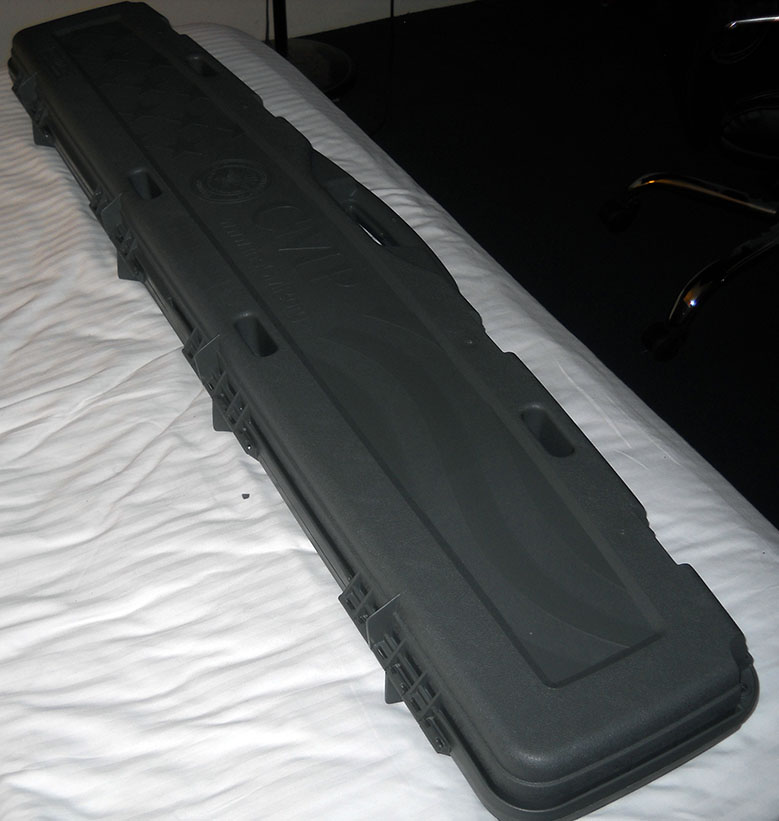
The CMP ships all its rifles in these lovely foam-lined hard plastic cases, suitable for baggage check on airplanes (note: this is legal), at no extra charge. They're even marked with the program's logo:
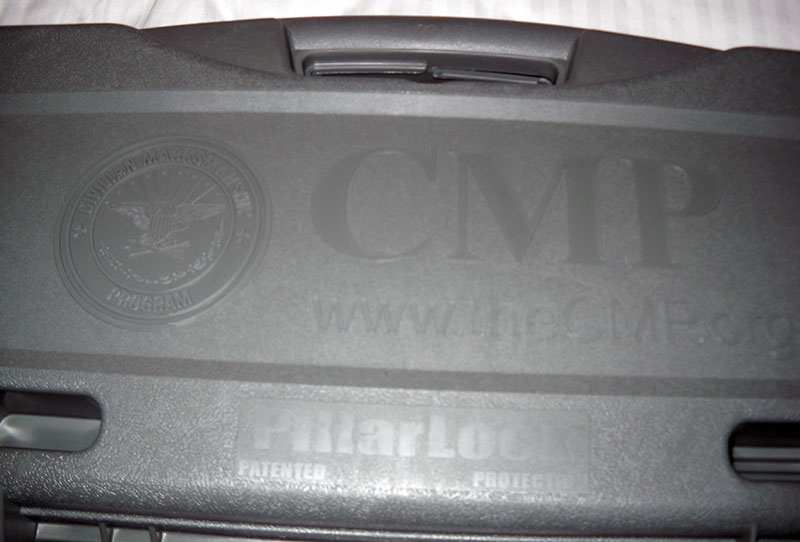
And inside, nestled in egg crate foam:
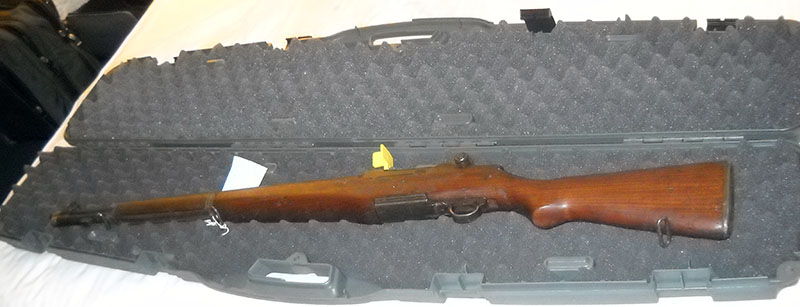
The M1 is a gas-operated semi-automatic rifle. What this means is that there's a small hole in the barrel out near the muzzle; as the bullet travels, there is a very brief span of time in which it has passed the gas port but hasn't left the muzzle yet, so that the port is subjected to very high gas pressure. Some of this high-pressure gas passes through the port into a cylinder underneath the barrel, where it drives a piston backward. The piston is connected via a long operating rod to the action of the rifle, which is driven back by the op rod. This unlocks and opens the bolt, extracts and ejects the empty casing, and recocks the concealed single-action hammer.
All of this takes place in a fraction of a second, by which time the bullet has left the barrel and the rest of the excess gas pressure vents through that much larger opening. The pressure on the piston goes away, at which point the tension of the action's recoil spring drives the action, and the op rod, and the piston all forward again. The bolt picks up a new cartridge, chambers it, and locks, and the rifle is ready to fire again.
Here's the chamber when locked open, as viewed from the lefthand side (note the yellow plastic "open chamber" indicator, included with purchase by the CMP; this is meant to be a positive indicator that the rifle is unloaded, since if it were otherwise the flag couldn't possibly be there).
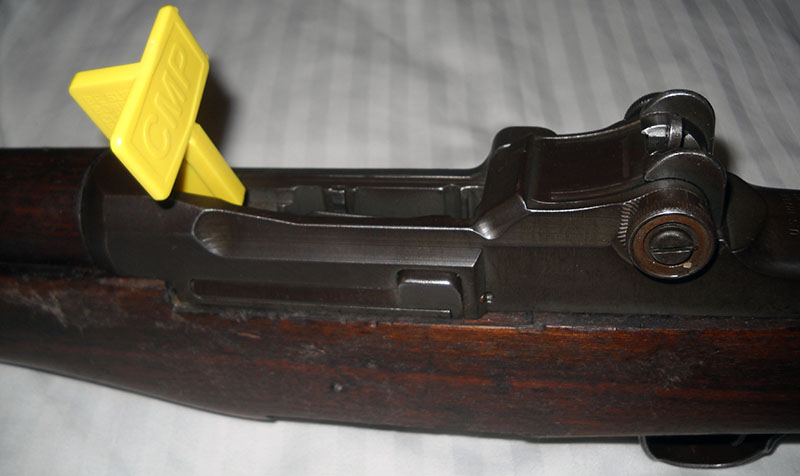
Same view from the right, with the indicator removed:
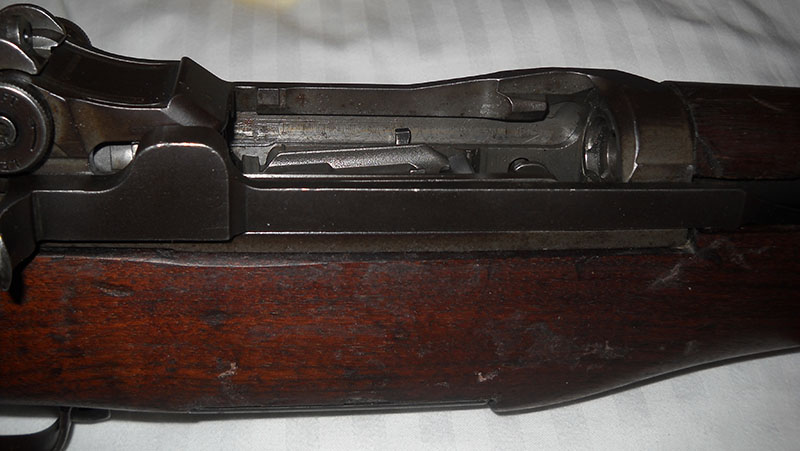
Note, at the extreme left of the shot (that is to say, toward the rear of the rifle), the curved tab sticking out; that is the operating handle.
Top view, muzzle to the left.
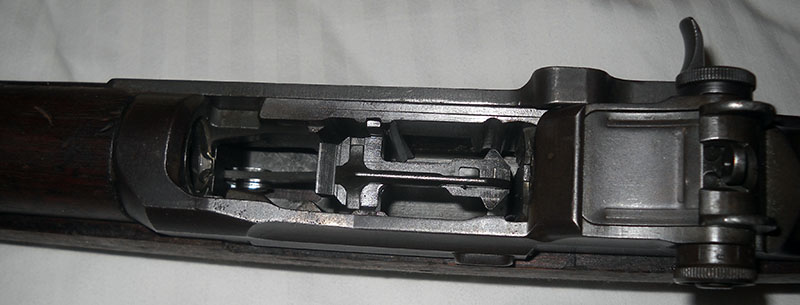
Better view of the operating handle. That structure in the middle is the magazine follower, which has that fin in the middle because it's designed to feed from either side of a two-column magazine.
The M1 uses an enbloc clip feeding system. This is different from the stripper clip we looked at in the SMLE and Mosin-Nagant GotWs, in that the clip stays with the ammunition and the whole thing goes into the magazine. In the M1, when the eighth and last round is fired, the rifle automatically ejects the clip, which makes a distinctive ping! sound you will probably have heard in movies and/or while playing Medal of Honor Allied Assault. Contrary to popular myth, this was not really the tipoff to the enemy it's often assumed to be, because, well, battlefields are hella noisy and most likely the guy holding the rifle is the only one who's going to hear it.
I don't have any .30-'06 ammunition right now, so I can't include my own picture of a loaded clip, but you can see three of them with the rifle in the Wikimedia picture I used at the top of the article.
This is probably a good place to talk about M1 Thumb. The manual that came with my rifle has this to say about it:
A SYMPATHETIC WARNING ABOUT "M1 THUMB"The bolt of the M1 rifle can slam shut unexpectedly if the shooter has not strictly followed these instructions. If your thumb or finger is in its path, a painful condition called "M1 Thumb" is a strong possibility. In a half-century of military service with the United States and its foreign allies, the M1 has bitten thousands of recruits in this manner. No one ever died from it, but it did lead to a deplorable expansion of vocabulary in many languages.
One of the ways in which the M1's bolt can catch its operator out is down to a quirk of the magazine follower's design. That ridge in the middle, meant to guide rounds from the left or right side of the clip into the right position for loading, can catch the bolt when it's drawn back on an empty magazine. This may lead the incautious shooter to believe the bolt is locked open, but it's not—it's just being held there by the magazine follower's spring tension, where the bolt face has caught on that ridge. It doesn't take much to dislodge it under those conditions, and bang! The recoil spring slams it shut.
The way the magazine system is supposed to work, if the bolt is all the way back and properly locked open, is that pushing a fresh clip into the magazine disengages the bolt stop when the clip is all the way down and locked, which gives the shooter sufficient time (theoretically) to push it in there and then pull his thumb out. If it's just held on the follower, the instant you put the new clip in there and push the follower down, snap. Either you just closed the bolt on your thumb, or a partially loaded clip, or both. Not a productive use of time, anyway. It's also possible to get bitten just by handling the rifle thinking it's locked when it isn't, dislodging the follower and closing the bolt when you weren't expecting it to close. Make sure you've pulled the dang thing all the way back, is what I'm getting at here. :)
Here's the chamber from the right side again, closed.
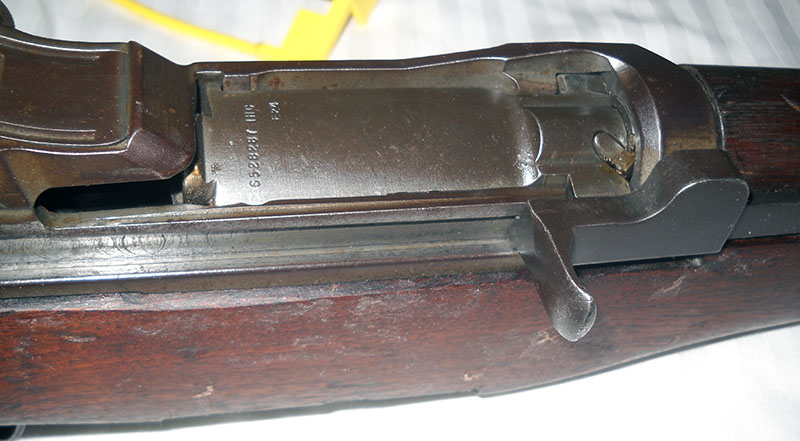
Comparing this shot with the open-chamber one from the same side, and the overview pic at the top, you can get a sense for the travel of the op rod. Shooters are advised to keep their supporting hands clear of that area, as interfering with the op rod will keep the rifle from functioning properly (and probably hurt).
Out at the business end, we can get a good look at the shrouded front sight and the front end of the gas system:
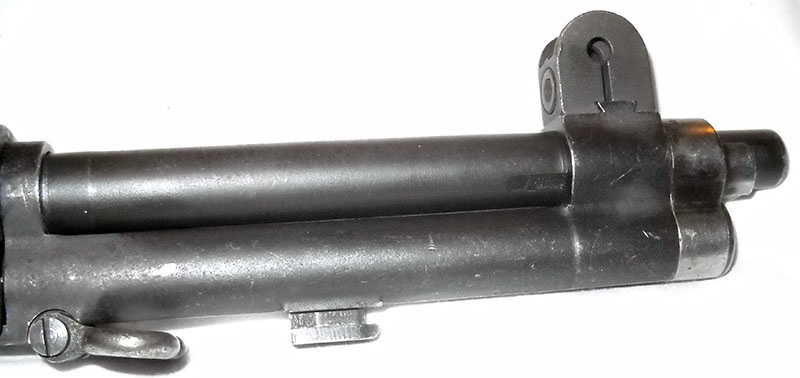
One problem they had with these in the field, as related by General Hatcher, is that the end of the gas piston won't take the Parkerizing finish the steel parts of the rifle have, because the piston is stainless steel. Upon issue they were painted with a black enamel paint to reduce their visibility, but as you can see here, that wore off fairly quickly, leading troops to undertake various field expedient measure to keep their gas pistons from giving them away (boot polish probably saw more use on those than on boots under battle conditions).
Also evident in this shot is the bayonet lug underneath the gas cylinder.
Here is a closer view of the muzzle and the cap at the front of the gas piston assembly, which is slotted for a removal tool.
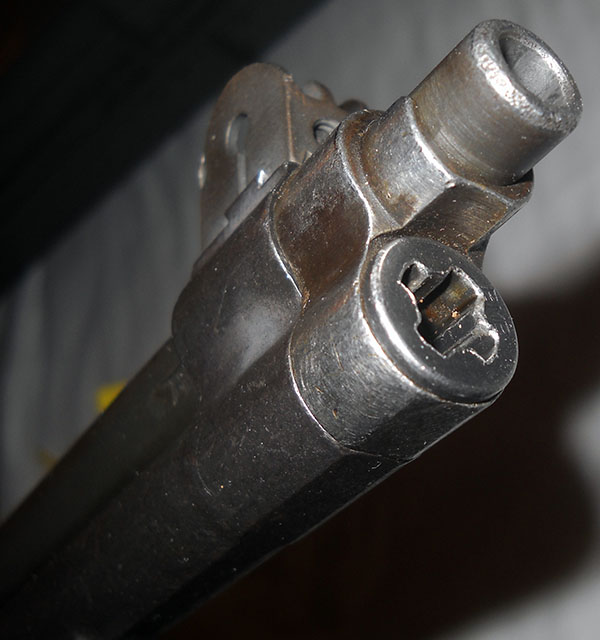
The M1 has a large, multi-adjustable aperture rear sight. When the rifle was initially fielded, some noncoms complained that the aperture was too big for precise marksmanship. It had to be explained to them that the M1 is not really for precise marksmanship, not to the extent that, e.g., the Springfield was. They can be made very accurate (for instance, the match-grade models my grandfather and his colleagues on the USAR Service Rifle Teams used), but, like the M1911 pistol, out of the box they're good enough to do the job they were primarily intended for and nothing more. And for battlefield running-and-gunning, the nice big opening on the M1's stock peep sight is reportedly ideal.
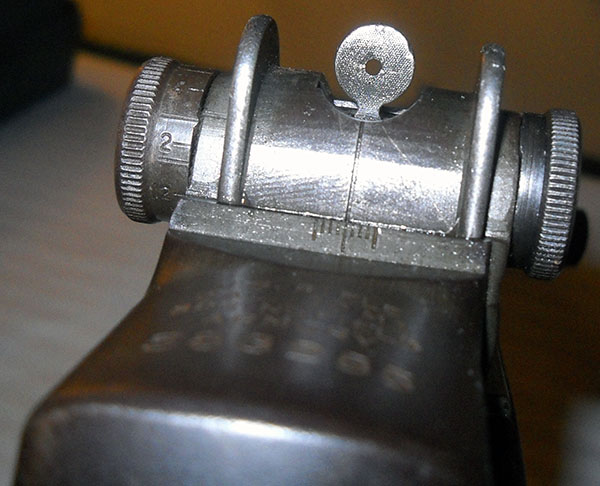
Blurrily in the foreground of that shot, you can see the markings engraved on the rear of the receiver. Here's a closer look at those. I'm not going to bother blurring the serial number, as the CMP keeps excellent records and I'm doubtful anyone would be able to pull any shenanigans with it, even if anyone around here were inclined to.
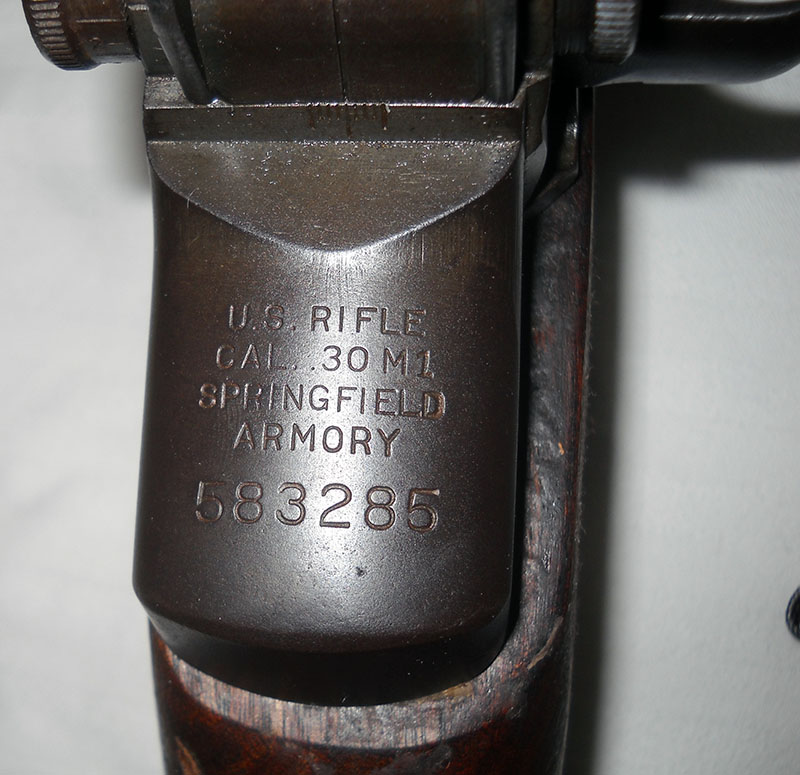
During the war, thanks to the astonishing demand, M1 rifles were manufactured under license by a number of government contractors, including the rifle manufacturers Winchester and Harrington & Richardson, and, interestingly, International Harvester (the tractor company). As you see here, mine is a genuine government-made Springfield. I didn't specifically order it that way; this is a "field grade" rifle, the second-lowest-quality grade the CMP sells (above "rack grade"), and one takes one's chances as to which manufacturer one's rifle originally came from at that level.
According to several agreeing sources on The Internet (all of which are probably quoting the same book by one Scott A. Duff), that serial number indicates that my rifle was made sometime in the second half of April, 1942. For historical perspective, that is four and a bit months after the Japanese attack on Pearl Harbor that brought the United States into World War II. At that point in the war, US forces were really only involved in the Pacific, where they already were when the war began, and had not yet gotten involved in Europe or Africa at all. Even the U.S. 8th Army Air Force, which would conduct strategic bombing operations against Germany well before American infantry made it onto the Continent in 1944, didn't begin operating from their bases in England until August of 1942.
Interestingly, one thing that US forces did do in April 1942 was Doolittle's raid on Tokyo, in which a group of daft bastards in B-25s (note: not naval aircraft) took off from an aircraft carrier in the Pacific, bombed the Japanese capital years before the Japanese government had told its citizenry America would be in any position to retaliate for Pearl Harbor, and then ended up scattered hell to breakfast around China because they didn't have the range to go anywhere else. This was a tactical disaster and was never really expected to be anything else, but psychologically it proved to be hugely important to outcomes on both sides. The raid happened on the 18th of April, 1942—right around the same time my rifle was coming off the line in Springfield.
So that's pretty cool.
There are a few other markings on the rifle, stamped into the stock.
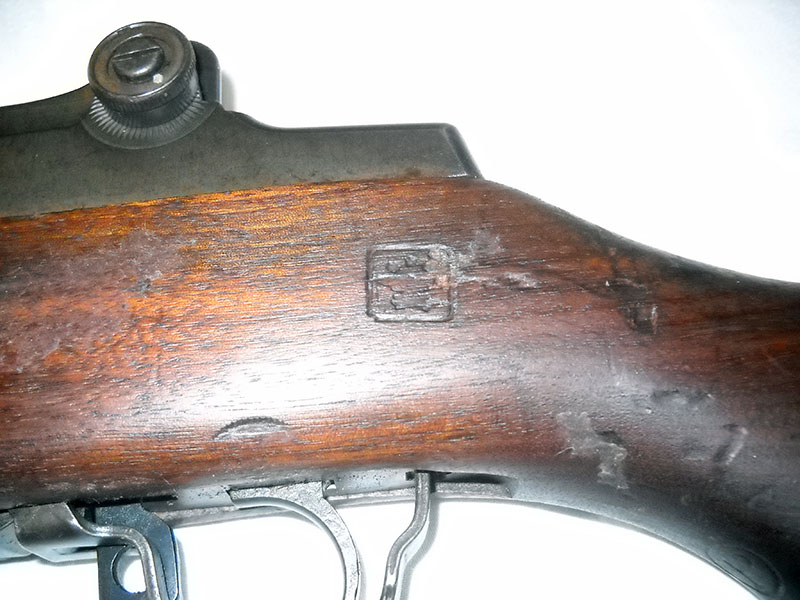
Unfortunately the principal one appears to have been obscured, possibly as part of the demilitarization process when the weapon was finally removed from government inventory. I think it was probably the crossed cannons symbol of the Ordnance Department. Also visible in this shot is the circled P that indicates the rifle has been proofed (pressure-tested) and certified fit for service.
It also came with this helpful tag attached, informing me that as part of the CMP's arsenal process, the rifle was examined and found to be within the Army's old acceptable tolerance limits in terms of headspace and wear.
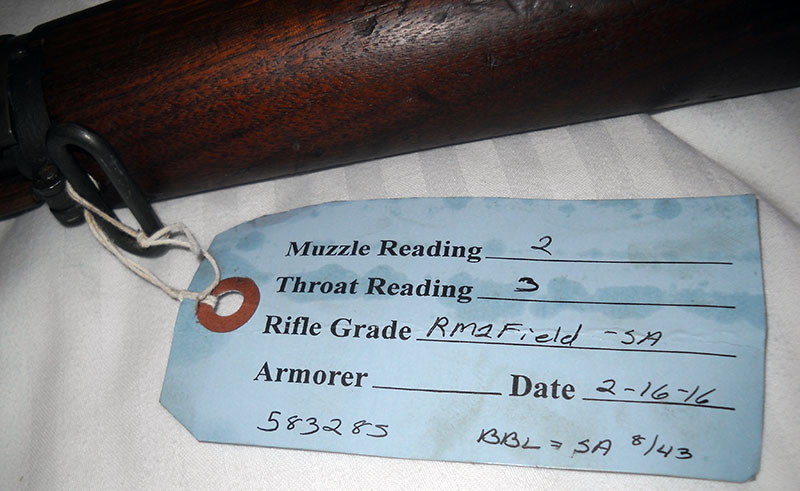
I haven't opened the buttplate compartment yet, but I would guess that, at its age and grade, my rifle is missing its original tool kit and grease container. Replacements are available online, particularly of the delightfully named Tool, Combination, Screw Driver, Wire Brush, and Bolt Assembly and Disassembly, affectionately known as the Combo Tool.
Heavy, overpowered, and occasionally bitey though it was, the M1 was well-loved by most of those who relied on it in combat, and served as the United States Army's principal infantry rifle until 1959, when it was replaced in that role by its younger brother the M14 (essentially an M1 in 7.62x51mm NATO/.308 Winchester, with a select-fire trigger group and detachable box magazine). The US Marine Corps was slower to adopt it (partly because they didn't get any new equipment before the Army had as much as it wanted back then, partly because of a bias for bolt-action precision shooting built into the "every Marine a rifleman" ethos), but once the Marines on Guadalcanal, who still had their M1903 Springfields, saw the Garand in action in the hands of the Army units who came to reinforce them, the Corps was pretty well sold on the idea too and started clamoring for its share. By war's end, all American infantrymen not designated for some special weapon or another (BAR, submachine gun, what have you) were carrying M1s.
Millions of M1s were made before and during World War II, so the Army couldn't replace them with M14s overnight; they were still being phased out of inventory when the M14 was itself replaced by the M16 in the '60s, and remained in some specialized roles until 1976. They can still be seen, being thrown around with startling abandon by young men with very powerful forearms, in Marine drill demonstrations, and (usually painted white) in various ceremonial roles at e.g. the Veterans Day and Memorial Day observances held annually at cemeteries and war memorials around the US. Most, however, are now in private hands, thanks to civilian sales through the CMP and general surplus sell-offs over the years. Hands like mine! Which is how we came to be here in the first place.


 RE: Gun of the Week: M1
RE: Gun of the Week: M1 RE: Gun of the Week: M1
RE: Gun of the Week: M1 RE: Gun of the Week: M1
RE: Gun of the Week: M1
 RE: Gun of the Week: M1
RE: Gun of the Week: M1 RE: Gun of the Week: M1
RE: Gun of the Week: M1
 RE: Gun of the Week: M1
RE: Gun of the Week: M1
 RE: Gun of the Week: M1
RE: Gun of the Week: M1 RE: Gun of the Week: M1
RE: Gun of the Week: M1 RE: Gun of the Week: M1
RE: Gun of the Week: M1 RE: Gun of the Week: M1
RE: Gun of the Week: M1 Rifle ASMR
Rifle ASMR
 Weird and Embarrassing
Weird and Embarrassing
 Speaking of Hatcher's
Speaking of Hatcher's
 RE: Weird and Embarrassing
RE: Weird and Embarrassing Printer-friendly copy
Printer-friendly copy

















